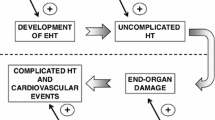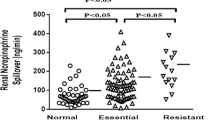Abstract
Numerous prospective studies have shown that high heart rate is related to the development of hypertension, atherosclerosis, and incidence of cardiovascular events. Experimental studies in monkeys have shown that high heart rate has direct atherogenic effects on the arteries as a result of increased wall stress. However, clustering of several risk factors for coronary artery disease in persons with high heart rate suggests that sympathetic overactivity also accounts for part of the increased cardiovascular morbidity that is observed in persons with tachycardia. Indeed, experimental studies have shown that heightened sympathetic tone can cause obesity, hyperinsulinemia, and insulin resistance, which in the long term can promote the development of atherosclerosis. Through its interaction with plasma insulin, sympathetic overactivity can promote the development of left ventricular hypertrophy. Sympathetic activation can also increase hematocrit and precipitate a procoagulant state. Angiotensin II has an effect both on the central nervous system, enhancing sympathetic outflow, and on the peripheral sympathetic nerves. Among the angiotensin II receptor antagonists, eprosartan showed a particular ability to block presynaptic angiotensin II receptor 1 (AT1) receptors at neuro-effector junctions in the sympathetic nervous system, as well as AT1 receptors in blood vessels. This dual action may represent an important advance in treatment of elevated blood pressure.
Similar content being viewed by others
References
MacMahon S, Peto R, Cutler J, et al.: Blood pressure, stroke, and coronary heart disease, part I: prolonged differences in blood pressure: prospective observational studies corrected for the regression dilution bias. Lancet 1990, 335:765–774.
Multiple Risk Factor Intervention Trial Research Group: Mortality after 10 1/2 years for hypertensive participantes in the Multiple Risk Factor Intervention Trial (dMRFIT). Circulation 1990, 82:1616–1628.
Palatini P, Julius S: Heart rate and cardiovascular risk. J Hypertens 1997, 15:1–15.
Collins R, Peto R, MacMahon S, et al.: Blood pressure, stroke, and coronary heart disease. Part 2, Short-term reductions in blood pressure: overview of randomised drug trials in their epidemiological context. Lancet 1990, 335:827–838.
Kannel WB, Brand N, Skinner JJ Jr, et al.: The relation of adiposity to blood pressure and development of hypertension. Ann Intern Med 1967, 67:48–59.
Julius S, Valentini M, Palatini P: Overweight and hypertension: a two-way street? Hypertension 2000, 35:807–813.
Narkiewicz K, Somers V, Mos L, et al.: An independent relationship between plasma leptin and heart rate in untreated patients with essential hypertension. J Hypertens 1999, 17:245–249.
Landsberg L, Krieger DR: Obesity, metabolism, and the sympathetic nervous system. Am J Hypertens 1989, 2:125S-132S.
Trimarco B, Volpe M, Ricciardelli B, et al.: Studies of the mechanisms underlying impairment of beta-adrenoceptormediated effects in human hypertension. Hypertension 1983, 5:584–590.
Volpe M, Trimarco B, Ricciardelli B, et al.: Effects of oral salt loading on beta-adrenergic receptor responsiveness in normal and hypertensive subjects. Cardiovasc Res 1982, 16:732–737.
American Diabetes Association: Detection and management of lipid disorders in diabetes. Diabetes Care 1993, 16:828–834.
Alberti KG: The clinical implications of impaired glucose tolerance. Diabet Med 1996, 13:927–937.
Fuller JH, Shipley MJ, Rose G, et al.: Coronary-heart-disease risk and impaired glucose tolerance. The Whitehall study. Lancet 1980, 1:1373–1376.
Laakso M, Lehto S: Epidemiology of risk factors for cardiovascular disease in diabetes and impaired glucose tolerance. Atherosclerosis 1998, 137(suppl):S65-S73.
Haffner SM: Impaired glucose tolerance, insulin resistance and cardiovascular disease. Diabet Med 1997, 14(suppl 3):S12-S18.
Fisher BM, Frier BM: Evidence for a specific heart disease of diabetes in humans. Diabet Med 1990, 7:478–448.
American Diabetes Association: Clinical practice recommendations 2000. Diabetes Care 2000, 23(suppl 1):S1-S116.
Hansson L, Zanchetti A, Carruthers SG, et al.: Effects of intensive blood-pressure lowering and low-dose aspirin in patients with hypertension: principal results of the Hypertension Optimal Treatment (HOT) randomised trial. HOT Study Group. Lancet 1998, 351:1755–1762.
Tuomilehto J, Rastenyte D, Birkenhager Wh, et al.: Effects of calcium-channel blockade in older patients with diabetes and systolic hypertension. N Engl J Med 1999, 340:677–684.
Widimsky J, Fejfarova MH, Fejfar Z: Changes of cardiac output in hypertensive disease. Cardiologia 1957, 31:381–389.
Schork NJ, Weder AB, Schork MA, et al.: Disease entities, mixed multi-normal distributions, and the role of the hyperkinetic state in the pathogenesis of hypertension. Stat Med 1990, 9:301–314.
Palatini P, Casiglia E, Pauletto P, et al.: Relationship of tachycardia with high blood pressure and metabolic abnormalities. A Study with Mixture Analysis in three Populations. Hypertension 1997, 30:1267–1273.
Gillman MW, Kannel WB, Belanger A, D‘Agostino RB: Influence of heart rate on mortality among persons with hypertension: The Framingham Study. Am Heart J 1993, 125:1148–1154.
Benetos A, Rudnichi A, Thomas F, et al.: Influence of heart rate on mortality in a French population. Role of age, gender, and blood pressure. Hypertension 1999, 33:44–52.
Deibert DC, DeFronzo RA: Epinephrine-induced insulin resistance in man. J Clin Invest 1980, 65:717–721.
Zeman RJ, Ludemann R, Easton TG, Etlinger JD: Slow to fast alterations in skeletal muscle fibers caused by clenbuterol, a beta-2-receptor agonist. Am J Physiol 1988, 254:E726-E732.
Jamerson KA, Julius S, Gudbrandsson T, et al.: Reflex sympathetic activation induces acute insulin resistance in the human forearm. Hypertension 1993, 21:618–623.
Palatini P, Vriz O, Nesbitt S, et al.: Parental hemodynamic circulation predicts insulin resistance in offspring. The Tecumseh Offspring Study. Hypertension 1999, 33:769–774.
Palatini P, Julius S: Association of tachycardia with morbidity and mortality: pathophysiological considerations. J Hum Hypertens 1997, 11(suppl 1):19–27.
Haffner SM, Fong D, Hazuda HP, et al.: Hyperinsulinemia, upper body adiposity, and cardiovascular risk factors in non-diabetics. Metabolism 1988, 37:338–345.
Smith SD, Julius S, Jamerson K, et al.: Hematocrit levels and physiologic factors in relationship to cardiovascular risk in Tecumseh, Michigan. Hypertension 1994, 12:455–462.
Sorlie PD, Garcia-Palmieri MR, Costas R Jr, Havlik RJ: Hematocrit and risk of coronary heart disease: the Puerto Rico Heart Health Program. Am Heart J 1981, 101:456–461.
Tarazi RC, Frohlich ED, Dustan HP: Plasma volume in men with essential hypertension. N Engl J Med 1968, 278:762–765.
Cohn JN: Relationship of plasma volume changes to resistance and capacitance vessel effects of sympathomimetic amines and angiotensin in man. Clin Sci 1966, 30:267–278.
Levy D, Anderson KM, Savage DD, et al.: Echocardiographically detected left ventricular hypertrophy: prevalence and risk factors. The Framingham Heart Study. Ann Intern Med 1988, 108:7–13.
Bauwens FR, Duprez DA, De Buyzere ML, et al.: Influence of the arterial blood pressure and nonhemodynamic factors on left ventricular hypertrophy in moderate essential/hypertension. Am J Cardiol 1991, 68:925–929.
Palatini P, Majahalme S, Nesbitt S, et al.: Determinants of left ventricular mass in young subjects with sympathetic overactivity. The Tecumseh Offspring Study. J Hypertens 2000, 18:769–775.
Devereux RB, Roman MJ: Hypertensive cardiac hypertrophy: Pathophysiologic and clinical characteristics. In Hypertension. Edited by Laragh JH, Brenner BM. New York: Raven Press; 1995:409–432.
Fagard R, Amery A: Physical exercise in Hypertension. In Hypertension. Edited by Laragh JH, Brenner BM. New York: Raven Press; 1995:2367–2388.
Pate RR, Pratt M, Blair SN, et al.: Physical activity and public health. A recommendation from the Centers for Disease Control and Prevention and the American College of Sports Medicine. JAMA 1995, 273:402–407.
Sever-PS, Poulter-NR: Hypertension drug trials: past, present, and future. J Hum Hypertens 2000, 14:729–738.
Davis B, Furberg CD: Antihypertensive and lipid-lowering treatment to prevent heart attack (ALLHAT) trial: interim results. J Am Coll Cardiol 2000, 36:325.
Van Zwieten PA: Centrally acting antihypertensives: a renaissance of interest. Mechanisms and haemodynamics. J Hypertens 1997, 15(suppl 1):S3-S8.
Stadler P, Leonardi L, Riesen W, et al.: Cardiovascular effects of verapamil in essential hypertension. Clin Pharmacol Ther 1987, 42:85–92.
Kailasam MT, Parmer RJ, Cervenka JH, et al.: Divergent effects of dihydropyridine and phenylalkylamine calcium channel antagonist classes on autonomic function in human hypertension. Hypertension 1995, 26:143–149.
Mizunuma Y, Suzuki-Kusaba M, Hisa H, et al.: Participation of angiotensin II in presser response and norepinephrine release to spinal nerve stimulation in pithed rats. Biol Pharmacol Bull 2000, 23:1455–1457.
Kaul CL, Ramarao P: Renin release and the sympathetic nervous system. Drugs Today 2000, 36:699–713.
Brooks DP, Ohlstein EH, Ruffolo RR: Pharmacology of eprosortan, an angiotensin II receptor antagonist: exploring hypotheses from clinical data. Am Heart J 1999, 138(suppl S):S246-S251.
Preobrazhensky DV, Stepanova OA, Kiktev VG, Shatunova IM: Eprosartan: a novel angiotensin II receptor antagonist with sympathoinhibitory activity. Clinical efficacy and safety in arterial hypertension. Kardiologiya 2000, 40:93–99.
Author information
Authors and Affiliations
Rights and permissions
About this article
Cite this article
Palatini, P. Sympathetic overactivity in hypertension: A risk factor for cardiovascular disease. Current Science Inc 3, S3–S9 (2001). https://doi.org/10.1007/s11906-001-0065-z
Issue Date:
DOI: https://doi.org/10.1007/s11906-001-0065-z




